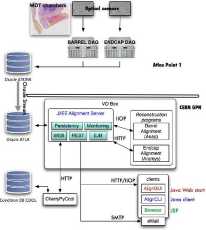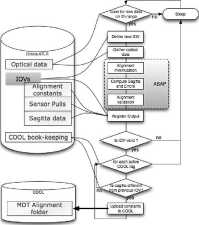7884079599
5) Oracle Database for the alignment monitoring tables, optical sensors data and conditions data, maintained centrally by CERN IT.
The usage of a server delivering methods to retrieve, update and insert data in Oracle allows common DB access methods for Aramys and Asap. Remote clients can connect to the server by means of different protocols (HTTP, HOP) in order to manage all the data stored in Oracle. The server runs regular monitoring tasks to provide fast feedback on the system status.


Figurę 3. General view of the software chain
Figurę 4. Barrel alignment flow chart
Alignment algorithm flow chart: the alignment algorithm fits 6 positional parameters of the
precision chambers and 11 deformation parameters, for a total of 21K degrees of freedom, via a minimization process that provides as output a set of geometry corrections to apply to every chamber in the muon spectrometer. The Asap alignment algorithm is written in C++ and makes (extensive) use of the ROOT[8] framework for the input and output data (ROOT trees).
The alignment monitoring is a Java application deployed inside a J2EE server[9] and relies on standard APIs for data persistency, DB connections management, authorization and authentication (among others). The server sits between the client software and the DB (multi-tier model architecture). The alignment reconstruction is managed by schedulers (fig.4): the server seeks new optical sensor data every few hours (the freąuency can be configured), and the correspondent IOV found is recorded in a table. It retrieves then the data inside the IOV time ranges, starts the alignment reconstruction (calling Asap as an external library via the CORBA HOP protocol) and Stores all output parameters for that IOV in Oracle. The new corrections are validated and uploaded to the conditions database if different from the previously stored data (a cut on maximum sagitta over all sectors is used).
3. Alignment Monitoring services
The alignment monitoring server delivers services that are implemented as Java MBeans (Managed Beans). These singleton objects, available inside the application server or via remote
Wyszukiwarka
Podobne podstrony:
5) Oracle Database for the alignment monitoring tables, optical sensors data and conditions data, ma
About Program Codę Stored in the Database Oracle Database offers the ability to storę program codę i
About Undo Data Whcn a transaction modifies data, Oracle Database copies the original data before mo
Siko0001 Task types for the orał test in methodology —2011 1. Prepare and give a s
51 (337) 3.3.1. Therapy for the brachialis. Starting Position: P: Supine; right arm and forearm both
Idea działania CIP4 CIP4 (The International Coorporation for the Integration of Processes in Prepres
ISO/IEC DTR 13335-2 Information technology - Guidelines for the management of IT security -Part 2: P
The Cłassic Film CołłectionUnforgiven The basis for the dassic movie directed by ]OHN HllSTON and st
ape 085 SECTION VI. COLD HANDS AND FEET. For the rather common complaint of cold hands and feet some
26 (738) 2.2.5. Therapy for the teres major. Starting Position: P: Supine; knees a
A J2EE based server for Muon Spectrometer Alignment monitoring in the ATLAS detector Journal of
About Tables The table is the basie unit of data storage in an Oracle database. It holds all user-ac
b00d7955c796f95dcd56f32e9bcb8cc1 Expertlndexing in OracleDatabase 11 g Maximum Performance for your
00191 a4ab5beeb4c3cfe7a2880a204d4051 10Strategies for Statistical Monitoring of Integral Control f
00193 ?7fc11aa847338bb01b7ea0e7ff2d66 195Strategies for Statistical Monitoring of Integral Control
więcej podobnych podstron